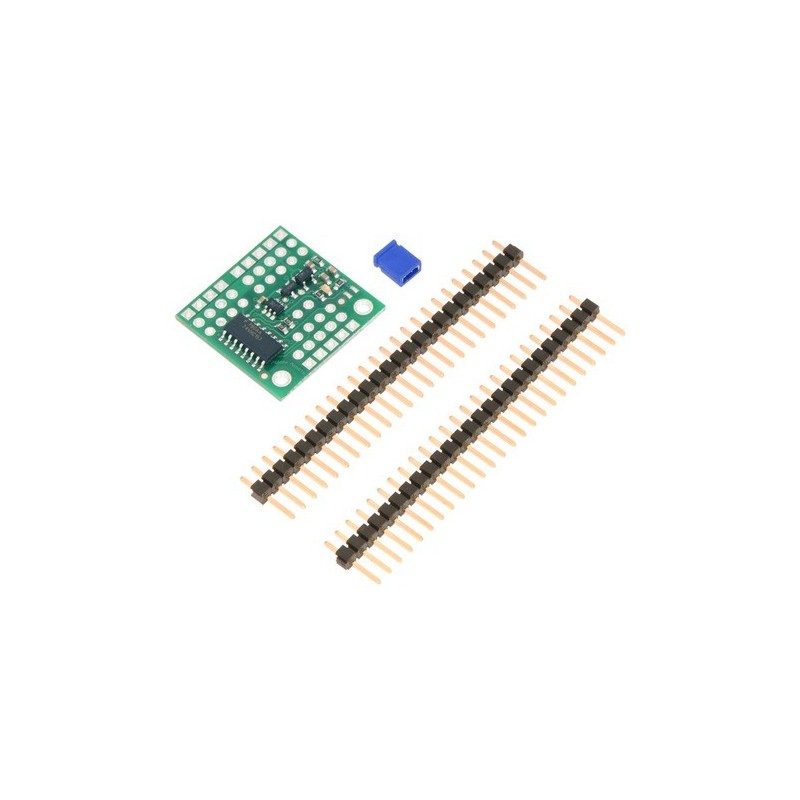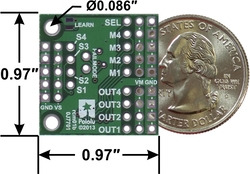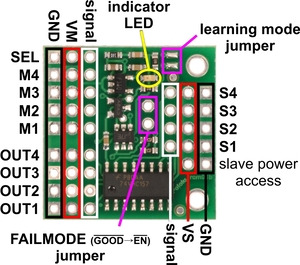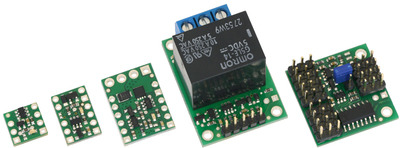

This compact four-channel multiplexer of hobby radio control pulses allows for easy switching between two independent signal sources. An auxiliary channel selects whether the output comes from the master or the slave source. The activation threshold and direction are configurable. Surface-mount components are pre-assembled on the PCB, but through-hole components are not installed and require soldering.
 |
The Pololu 4-Channel RC Servo Multiplexer can be used with standard hobby radio control systems and servo controllers to allow easy switching of servo control between two independent sources using a separate auxiliary channel as the input selector. This makes it ideal for applications in which you have two possible control sources and want to be able to switch between them on the fly. For example, you could connect two RC receivers to the same set of servos or electronic speed controls (ESCs) and allow the master transmitter to decide whether the master or slave transmitter is in control, thereby setting up your own buddy-system training setup. Another possible application would involve multiplexing between an RC receiver and a servo controller, which would allow you to switch between autonomous and manual control of a set of servos. The RC multiplexer is available preassembled with male header pins or as a partial kit that allows for greater application flexibility and more compact installations.
 |
The RC multiplexer measures the width of incoming RC pulses on the channel labeled SEL and compares it to a user-configurable threshold (with ą64 µs of hysteresis) to decide whether the master (M1–M4) or slave (S1–S4) inputs to the multiplexer should show up on the output channels (OUT1–OUT4). By default, the threshold is approximately 1700 µs and the slave inputs are only selected when the pulses on SEL are above this threshold. The multiplexer has a learning mode that allows you to change the threshold and activation direction. A yellow indicator LED provides feedback about the state of the RC multiplexer.
When the RC signal on the SEL channel is lost or invalid, the optional FAILMODE jumper determines the output behavior. If the jumper is left off, the master inputs will be in control. If the jumper is connected, the output channels go low and stay low for as long as the signal on the SEL channel remains invalid. For many servos and ESCs, a constant low on the signal line will turn them off, which might be desirable if the control signals are known to be bad.
The multiplexer considers the RC signal on the SEL channel to be valid if it has a 10–330 Hz pulse rate and 0.5–2.5 ms pulse width. The other inputs (S1–S4 and M1–M4) are unrestricted.
The power supplied by the master RC device should be between 2.5 and 16 V, and it must be capable of supplying the current that the servos connected to the outputs draw. The power pins of the SEL, M1–M4, and OUT1–OUT4 channels are all connected to the same VM rail, and the multiplexer draws its power from those pins. The power pins of the S1–S4 inputs are connected to each other on the VS rail but are not used by the board.
More information about using this product can be found in the user’s guide.
This product replaces items #721 and #722.
The Pololu 4-Channel RC Servo Multiplexer is available in two versions:
|
|
The RC multiplexer is essentially our Pololu RC Switch with digital output combined with a quad 2-input multiplexer. The LED behavior and configuration procedures are the same. However, the RC switches have a safe-start feature that is not enabled on the RC multiplexer. The RC switches have a GOOD output that is high when the signal is good, while the RC multiplexer has a GOOD output that is low when the signal is good (this signal can be accessed via the upper/octagonal pad of the FAILMODE jumper). The RC switches have an OUT output that indicates whether the switch is active; the RC multiplexer has the same signal, but it is not easily accessible.
 |
| The Pololu RC Switch family of products. |
|---|
Producent BTC Korporacja sp. z o. o. Lwowska 5 05-120 Legionowo Polska sprzedaz@kamami.pl 22 767 36 20
Osoba odpowiedzialna BTC Korporacja sp. z o. o. Lwowska 5 05-120 Legionowo Polska sprzedaz@kamami.pl 22 767 36 20
Uniwersalny tester serwomechanizmów oraz regulatorów ESC. Umożliwia sprawdzenie działania serwa bez potrzeby korzystania z nadajnika i odbiornika
Płytka rozszerzeń dla BBC micro:bit, umożliwiająca łatwe podłączenie i sterowanie serwomechanizmami niskiej mocy. Standardowo obsługuje dwa serwa, a po wyłączeniu wbudowanych diod ZIP LED nawet trzy. Zasilana trzema bateriami AAA, jednocześnie dostarcza energii do micro:bit, a włącznik chroni przed niepotrzebnym rozładowaniem. Dzięki pięciu diodom RGB ZIP LED oraz możliwości podłączenia dodatkowych, płytka pozwala na atrakcyjne efekty świetlne i jest idealna do projektów robotycznych, takich jak :MOVE mini. Kitronik 5623
Sterownik serwomechanizmów z interfejsem szeregowym UART. Wyposażony w moduł ESP32 z komunikacją bezprzewodową WiFi i Bluetooth. Waveshare Servo Driver with ESP32
Sterownik serwomechanizmów do zestawów FPGA TerasIC serii DE umożliwia sterowanie maksymalnie 24 serwomechanizmami. Dostarcza napięcie 6 V do zasilania serwomechanizmów. W zestawie serwomechanizm MG966R i taśma do połączenia z zestawem FPGA. P0288
Płytka rozszerzeniowa do minikomputera Raspberry Pi dodająca możliwość sterowania do 16 serw sygnałem PWM. Potrafi generować sygnał do 1,6 kHz z 12-bitową rozdzielczością. Dzięki sterowaniu za pomocą interfejsu I2C, do równoczesnego sterowania serw wystarczy użycie 2 pinów. Adafruit 2327
Moduł do sterowania serwem. Parametry pracy konfigurowane są za pomocą potencjometrów umieszczonych na płytce. SparkFun WIG-13118
Brak towaru
Adafruit Motorshield to shield umożliwiający łatwe sterowanie silnikami DC, krokowymi oraz serwomechanizmami przy pomocy Arduino. Zawiera sterowniki silników DC, krokowych oraz wyjścia do sterowania serwomechanizmami. Umożliwia adresowanie oraz łączenie ekspanderów (do 32) i sterowanie przy pomocy jednej płytki Arduino. Adafruit 1438
Kompaktowy sterownik serw oparty na układzie PCA9685, który umożliwia równoczesne sterowanie aż 16 serwomechanizmami RC. Płytka ma wbudowane złącze Edge Connector do bezpośredniego podłączenia micro:bit oraz pady w standardzie Link, co ułatwia integrację z innymi modułami. Zasilanie można doprowadzić przez blok zacisków lub złącza serw, a wbudowany wyłącznik i dioda LED ułatwiają obsługę. Sterownik udostępnia stabilizowane wyjście 3,3 V dla micro:bit i dodatkowych urządzeń, dzięki czemu może pełnić rolę centralnego modułu w projekcie. Kitronik 5694
Brak towaru
Rozszerzenie typu shield dla Arduino ze sterownikiem PWM 16-kanałowym, 12-bitowym pozwalającym na równoczesne sterowanie 16 serwomechanizmami za pomocą interfejsu I2C. Adafruit 1411
Brak towaru
Mini Maestro 12 w wersji kit to wielofunkcyjny kontroler do sterowania serwami, odczytu czujników i realizacji sekwencji ruchów bez komputera. Doskonały do zastosowań w robotyce, animatronice i systemach interaktywnych, umożliwia elastyczne sterowanie ruchem i obsługę peryferiów z poziomu PC lub mikrokontrolera.
Brak towaru
Płytka umożliwiająca sterowanie serwomechanizmem bez konieczności programowania. Sparkfun WIG-13872
Brak towaru
Uniwersalny tester serwomechanizmów oraz regulatorów ESC. Umożliwia sprawdzenie działania serwa bez potrzeby korzystania z nadajnika i odbiornika
Moduł 16-kanałowego sterownika serw z interfejsem I2C oparty o układ PCA9685. modPCA9685
Brak towaru
Moduł z 8-kanałowym sterownikiem serwomechanizmów. Pozwala na kontrolowanie prędkości ruchu oraz początkowej pozycji serwa. Cytron SC08A

